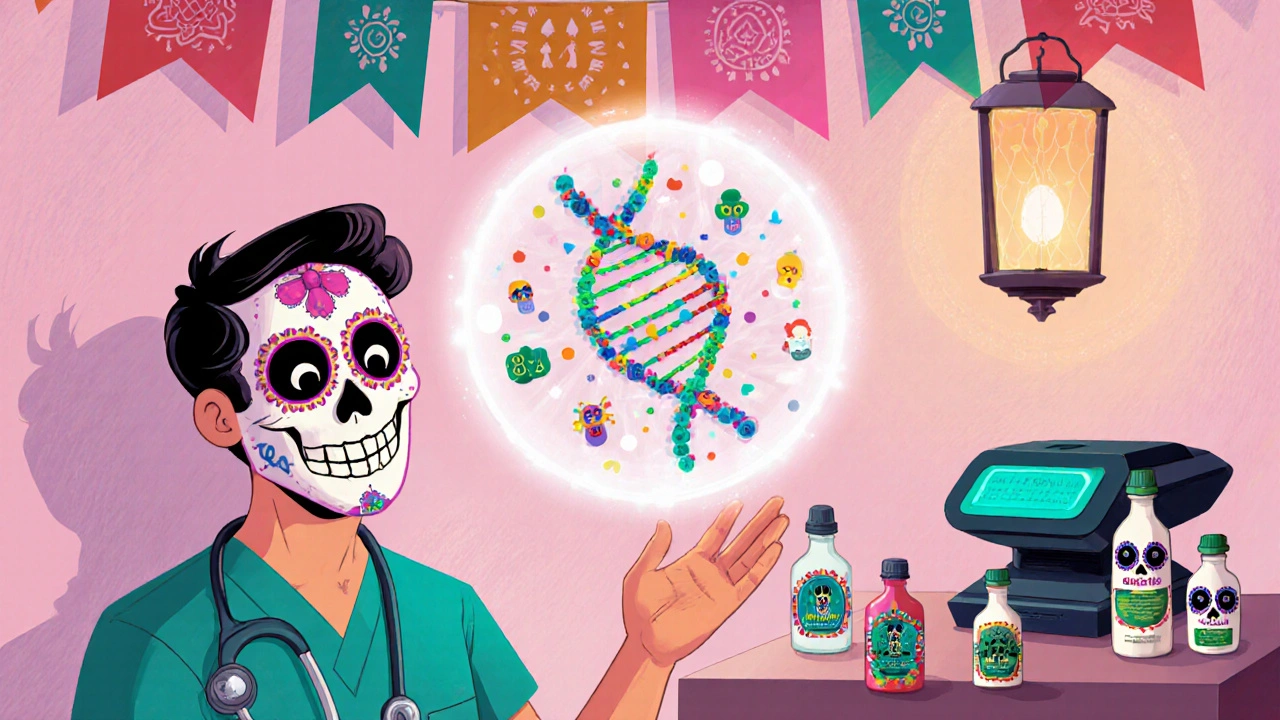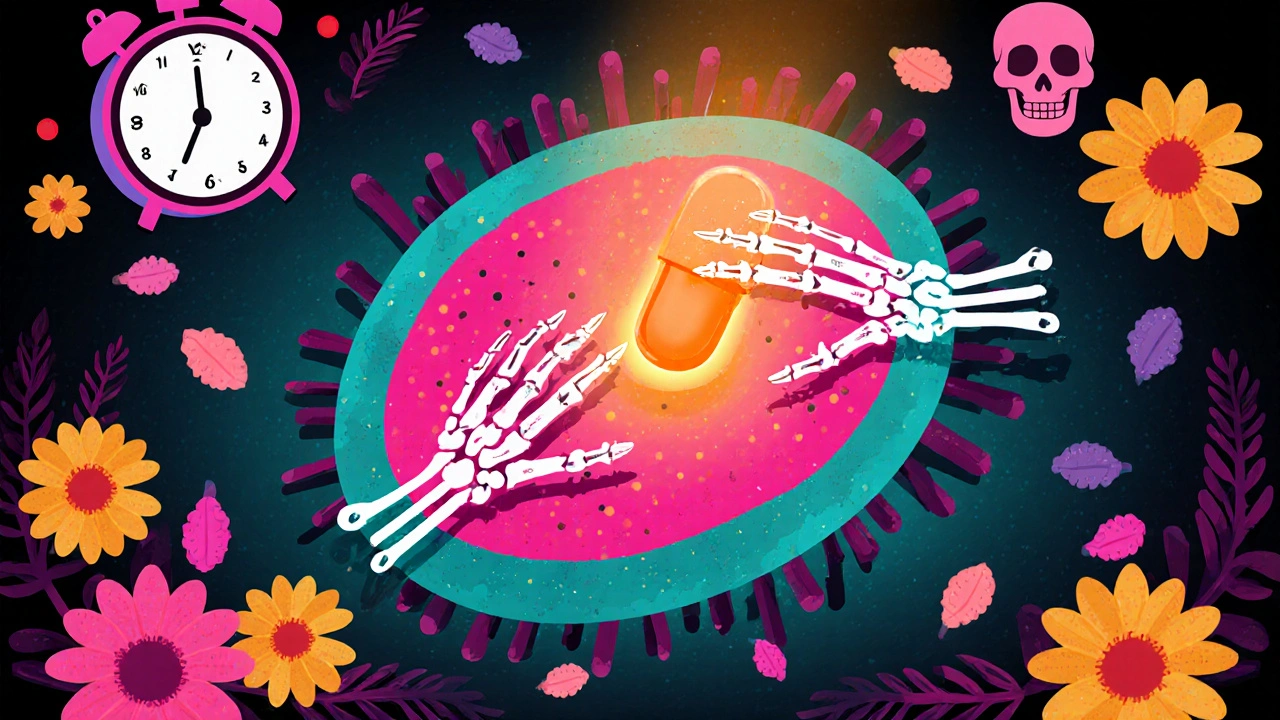Ribociclib Resistance Risk Calculator
This tool estimates your risk of developing ribociclib resistance based on key biomarkers. Use this to inform treatment decisions after ribociclib therapy.
Treatment Recommendation
Based on your biomarker profile, your healthcare provider may consider the following options:
No specific recommendations yet
Facing a tumor that stops responding to a once‑effective drug is frustrating for patients and doctors alike. Ribociclib resistance is emerging as a key obstacle in the fight against hormone‑receptor‑positive breast cancer, and understanding its clinical implications can shape the next line of therapy.
What Is Ribociclib?
When oncologists prescribe Ribociclib is a selective CDK4/6 inhibitor approved for hormone‑receptor‑positive, HER2‑negative breast cancer, they are targeting a critical checkpoint in the cell‑division cycle. The drug binds to cyclin‑dependent kinases 4 and 6, preventing phosphorylation of the retinoblastoma protein (Rb) and halting progression from the G1 to the S phase.
How CDK4/6 Inhibition Controls Tumor Growth
The CDK4/6‑Rb pathway sits at the crossroads of growth‑factor signaling and cell‑cycle control. In hormone‑driven Breast cancer is a type of cancer that relies on estrogen or progesterone signaling for proliferation, estrogen receptor (ER) activity up‑regulates cyclin‑D1, which partners with CDK4/6 to push cells past the G1 checkpoint. By blocking this partnership, ribociclib creates a state of cell‑cycle arrest that synergizes with endocrine therapy.
Why Resistance Happens: Molecular Mechanisms
Despite impressive progression‑free survival gains in trials like MONALEESA‑2, a subset of patients eventually experience Ribociclib resistance. Common mechanisms include:
- Up‑regulation of cyclin‑D1 - When Cyclin‑D1 is a regulatory protein that activates CDK4/6 is overexpressed, excess substrate can overwhelm inhibitor binding.
- Loss of functional Rb - Mutations or deletions render the downstream target irrelevant, bypassing the blockade.
- Activation of parallel pathways - The PI3K pathway is a signaling cascade that promotes growth and survival independent of CDK4/6 can drive proliferation despite CDK4/6 inhibition.
- Altered CDK6 expression - Increased CDK6 levels can dilute ribociclib’s potency.
- Epigenetic changes - Up‑regulation of CDK‑activating kinases (CAK) or down‑regulation of CDK inhibitors like p16INK4A.
Biomarkers That Predict Resistance
Identifying patients at risk allows clinicians to intervene earlier. Current research highlights:
- High baseline cyclin‑D1 mRNA or protein levels.
- Rb loss detected by immunohistochemistry.
- PI3KCA mutations or PTEN loss, measurable via next‑generation sequencing.
- Elevated CDK6 expression on tumor biopsies.
- Circulating tumor DNA (ctDNA) patterns that signal emerging pathway activation.

Therapeutic Strategies After Resistance
When resistance emerges, the treatment landscape offers several options:
- Switch to a different CDK4/6 inhibitor - Palbociclib is a CDK4/6 inhibitor with a slightly different binding profile or Abemaciclib is a CDK4/6 inhibitor that can be dosed continuously and shows activity against some resistant clones may overcome specific mutations.
- Combine with PI3K/AKT/mTOR inhibitors - Trials adding alpelisib (PI3Kα‑specific) or everolimus (mTOR) have restored sensitivity in pre‑clinical models.
- Intensify endocrine therapy - Switching from aromatase inhibitors to selective estrogen receptor degraders (SERDs) such as fulvestrant can be effective.
- Introduce chemotherapy - For rapid disease control, a short course of taxane‑based chemotherapy remains an option.
- Enroll in clinical trials - Novel agents targeting CDK2, CDK7, or degrader technologies are actively being tested.
Comparison of the Three FDA‑Approved CDK4/6 Inhibitors
| Attribute | Ribociclib | Palbociclib | Abemaciclib |
|---|---|---|---|
| FDA approval year (HR+/HER2‑) | 2017 | 2015 | 2017 |
| Dosing schedule | 3 weeks on / 1 week off | 3 weeks on / 1 week off | Continuous daily |
| Common grade≥3 AEs | Neutropenia, liver enzyme elevation | Neutropenia, infections | Diarrhea, neutropenia (less severe) |
| Blood‑brain barrier penetration | Limited | Limited | Higher (beneficial for CNS metastases) |
| Metabolic pathway | CYP3A4 | CYP3A4 | CYP3A4 |
Clinical Trial Insights on Resistance
Large phaseIII studies have begun to report on resistance patterns. In the MONALEESA‑7 trial (pre‑menopausal women), median progression‑free survival was 23.8months with ribociclib plus endocrine therapy, but a subset (~15%) showed early relapse linked to PI3KCA mutations. A post‑hoc analysis of MONALEESA‑3 demonstrated that patients with baseline cyclin‑D1 amplification had a 25% higher hazard of progression.
Real‑world registries echo these findings. A 2024 European cohort of 1,200 patients reported a median time‑to‑treatment‑failure of 14months for ribociclib, with resistance most often associated with loss of Rb expression (detected in 32% of resistant biopsies).

Future Directions: Monitoring and New Targets
Liquid biopsy is reshaping how clinicians spot resistance early. Serial ctDNA assays can detect emerging PI3KCA or ESR1 mutations weeks before radiographic progression, offering a window to switch therapy.
Beyond the existing trio, several next‑generation strategies are in the pipeline:
- CDK2 degraders - Early‑phase trials suggest they can bypass CDK4/6‑driven resistance.
- PROTAC‑based CDK4/6 degraders - Offering complete protein removal rather than inhibition.
- Combination immunotherapy - Pre‑clinical data show CDK4/6 inhibition may enhance tumor antigen presentation, potentially synergizing with checkpoint inhibitors.
While these approaches remain investigational, they illustrate a shift toward personalized, adaptive treatment pathways.
Practical Takeaways for Clinicians
- Screen baseline tumor tissue for Rb status, cyclin‑D1 levels, and PI3K pathway alterations.
- Consider early ctDNA monitoring after 3-4months on ribociclib to catch emerging mutations.
- If resistance is confirmed, evaluate switching to abemaciclib or adding a PI3K inhibitor before moving to chemotherapy.
- Enroll eligible patients in trials targeting CDK2 or using PROTAC degraders.
Frequently Asked Questions
What defines ribociclib resistance?
Resistance occurs when disease progresses despite continuous ribociclib therapy, usually confirmed by imaging or rising tumor markers, and is often linked to molecular changes such as Rb loss, cyclin‑D1 amplification, or activation of the PI3K pathway.
Can I switch to another CDK4/6 inhibitor after resistance?
Yes. Some patients respond to palbociclib or abemaciclib after ribociclib failure, especially when the resistance mechanism is related to drug‑specific pharmacokinetics rather than a shared downstream alteration.
Should I add a PI3K inhibitor to overcome resistance?
For patients whose tumors harbor PI3KCA mutations or PTEN loss, combining a PI3K inhibitor (e.g., alpelisib) with endocrine therapy-sometimes with continued CDK4/6 blockade-has shown clinical benefit in trials.
How often should ctDNA be tested?
Many centers obtain a baseline sample, then repeat every 8‑12weeks during treatment. Early rises in mutant allele frequency can prompt a therapeutic switch before radiographic progression.
What are the most common side effects that could limit ribociclib use?
Neutropenia and liver enzyme elevations are the most frequent grade3 or higher toxicities. Regular blood counts and liver function tests are recommended every 2weeks for the first two cycles.








7 Comments
nitish sharma October 17, 2025
Understanding the molecular underpinnings of ribociclib resistance is paramount for optimizing patient outcomes. In clinical practice, assessing baseline cyclin‑D1 expression and Rb status can preempt therapeutic failure. Early integration of circulating tumor DNA monitoring enables timely identification of emergent PI3K or ESR1 mutations. Patients exhibiting high cyclin‑D1 mRNA should be counselled regarding alternative CDK4/6 agents or combinatorial strategies. Moreover, multidisciplinary collaboration ensures that dose modifications for neutropenia or hepatic toxicity are judiciously managed.
Sarah Hanson October 28, 2025
The biomarker panel you outlined is definitely a solid foundation for personalized therapy, definatly worth integrating into practice.
Nhasala Joshi November 7, 2025
Behold, the clandestine machinations of ribociclib evasion-an insidious symphony of cyclin‑D1 amplification, Rb abrogation, and PI3K hyperactivation that skulduggery the very tenets of targeted therapy! 🚀 The epigenetic rewiring, replete with CAK up‑regulation, crafts a formidable fortress against CDK4/6 inhibition. Concomitant elevation of CDK6 isoforms acts as a biochemical Trojan horse, subverting pharmacologic blockade. Emerging liquid‑biopsy analytics promise clandestine surveillance, yet the specter of adaptive resistance looms evermore. 🧬
kendra mukhia November 17, 2025
While the theatrical flair is entertaining, the data unequivocally demonstrate that resistance mechanisms such as Rb loss are not mere speculation but observable phenomena across large cohorts. Overstating conspiracy obscures the practical steps clinicians must take, namely baseline immunohistochemistry and strategic trial enrollment. One must prioritize evidence‑based sequencing over melodramatic narratives.
Barbara Grzegorzewska November 27, 2025
In the grand tapestry of oncology, ribociclib emerges as a veritable phoenix, yet its flame can be smothered by the insidious whispers of molecular sabotage. The intricate ballet of cyclin‑D1 and CDK6, when dysregulated, orchestrates a crescendo of resistance that is both elegant and perilous. It is imperative that clinicians cultivate a nuanced palate for these biochemical nuances, lest they fall prey to the blandness of one‑size‑fits‑all regimens. A dash of flamboyance in therapeutic design-perhaps an avant‑garde combo of PI3K inhibitors-could revitalize this beleaguered agent. Let us not succumb to pedestrian reasoning; instead, let us embrace the kaleidoscopic possibilities that modern oncology affords.
Nis Hansen December 7, 2025
The phenomenon of acquired resistance to CDK4/6 inhibition invites a philosophical reflection on the dialectic between tumor adaptability and therapeutic intent. One might argue that the cancer cell, in its relentless pursuit of survival, mirrors the existential struggle of any organism confronting an imposed constraint. When ribociclib imposes a G1 arrest, selective pressures engage, selecting for clones harboring mutations that circumvent the blockade. Empirical evidence demonstrates that loss of functional retinoblastoma protein constitutes a decisive bifurcation point in this evolutionary trajectory. Similarly, the up‑regulation of cyclin‑D1 creates a surplus substrate that saturates the inhibitory capacity of the drug. The activation of parallel pathways, notably PI3K/AKT/mTOR, furnishes an alternative conduit for proliferative signaling, effectively rendering CDK4/6 inhibition moot. From a systems‑biology perspective, this redundancy epitomizes the robustness inherent in cellular networks. Accordingly, contemporary clinical protocols advocate for the integration of molecular diagnostics, such as next‑generation sequencing, to preemptively identify these escape routes. The utility of circulating tumor DNA as a real‑time barometer of clonal dynamics cannot be overstated, as it permits therapeutic recalibration before radiographic progression manifests. Moreover, the strategic deployment of combination regimens-pairing ribociclib with PI3K inhibitors or selective estrogen receptor degraders-offers a synergistic assault on multiple nodes of the signaling web. Yet, the clinician must remain vigilant regarding additive toxicities, particularly hematologic and hepatic adverse events, which demand meticulous monitoring. In scenarios where resistance is mediated by CDK6 amplification, transitioning to abemaciclib, with its distinct pharmacokinetic profile, may restore efficacy. The burgeoning field of proteolysis‑targeting chimeras (PROTACs) promises to transcend mere inhibition, effecting complete degradation of CDK4/6 proteins. Such innovative approaches underscore the imperative of continual research investment to outpace the adaptive ingenuity of malignancies. Ultimately, the pursuit of durable control over hormone‑receptor‑positive breast cancer rests upon a harmonious blend of precise biomarker stratification, dynamic treatment adaptation, and an unwavering commitment to translational science.
Fabian Märkl December 18, 2025
Great summary! It's encouraging to see concrete strategies like ctDNA monitoring being highlighted 😊. Keeping an eye on emerging combos will certainly help us stay ahead of resistance.